Effect of Molar Mass on Critical Specific Work of Flow for Shear-Induced Crystal Nucleation in Poly (l-Lactic Acid)
Abstract
1. Introduction
2. Materials and Methods
3. Results and Discussion
3.1. Reptation Relaxation Time
3.2. Crystallization Kinetics and Semicrystalline Morphology of PLLA of Different Molar Mass after Shearing at Different Rates for 10 s
3.3. Interconvertibility of Shear Rate and Shear Time for Shear-Induced Nuclei Formation
4. Conclusions
Author Contributions
Funding
Institutional Review Board Statement
Informed Consent Statement
Data Availability Statement
Acknowledgments
Conflicts of Interest
References
- Polychronopoulos, N.D.; Vlachopoulos, J. Polymer Processing and Rheology. In Functional Polymers, Polymers and Polymeric Composites: A Reference Series; Mazumder, M.A.J., Sheardown, H., Al-Ahmed, A., Eds.; Springer: Cham, Switzerland, 2019. [Google Scholar]
- Osswald, T.A. Understanding Polymer Processing: Processes and Governing Equations; Hanser: München, Germany, 2017. [Google Scholar]
- Pantani, R.; Coccorullo, I.; Speranza, V.; Titomanlio, G. Modeling of morphology evolution in the injection molding process of thermoplastic polymers. Prog. Polym. Sci. 2005, 30, 1185–1222. [Google Scholar] [CrossRef]
- Haas, T.W.; Maxwell, B. Effects of shear stress on the crystallization of linear polyethylene and polybutene-1. Polym. Eng. Sci. 1969, 9, 225–241. [Google Scholar] [CrossRef]
- Kobayashi, K.; Nagasawa, T. Crystallization of sheared polymer melts. J. Macromol. Sci. Part B Phys. 1970, 4, 331–345. [Google Scholar] [CrossRef]
- Lagasse, R.R.; Maxwell, B. An experimental study of the kinetics of polymer crystallization during shear flow. Polym. Eng. Sci. 1976, 16, 189–199. [Google Scholar] [CrossRef]
- Wolkowicz, M.D. Nucleation and crystal growth in sheared poly(1-butene) melts. J. Polym. Sci. Polym. Symp. 1978, 63, 365–382. [Google Scholar] [CrossRef]
- Sherwood, C.H.; Price, F.P.; Stein, R.S. Effect of shear on the crystallization kinetics of poly (ethylene oxide) and poly (ε-caprolactone) melts. J. Polym. Sci. Polym. Symp. 1978, 63, 77–94. [Google Scholar] [CrossRef]
- Balzano, L.; Rastogi, S.; Peters, G.W. Crystallization and precursors during fast short-term shear. Macromolecules 2009, 42, 2088–2092. [Google Scholar] [CrossRef]
- Kornfield, J.A.; Kumaraswamy, G.; Issaian, A.M. Recent advances in understanding flow effects on polymer crystallization. Ind. Eng. Chem. Res. 2002, 41, 6383–6392. [Google Scholar] [CrossRef]
- Mykhaylyk, O.O.; Chambon, P.; Impradice, C.; Fairclough, J.P.A.; Terrill, N.J.; Ryan, A.J. Control of structural morphology in shear-induced crystallization of polymers. Macromolecules 2010, 43, 2389–2405. [Google Scholar] [CrossRef]
- Keller, A.; Kolnaar, J.W.H. Chain extension and orientation: Fundamentals and relevance to processing and products. Orientat. Phenom. Polym. 1993, 82, 81–102. [Google Scholar]
- Stern, C.; Frick, A.; Weickert, G. Relationship between the structure and mechanical properties of polypropylene: Effects of the molecular weight and shear-induced structure. J. Appl. Polym. Sci. 2007, 103, 519–533. [Google Scholar] [CrossRef]
- Zhang, N.; Choi, S.Y.; Gilchrist, M.D. Flow induced crystallization of poly (ether-block-amide) from the microinjection molding process and its effect on mechanical properties. Macromol. Mater. Eng. 2014, 299, 1362–1383. [Google Scholar] [CrossRef]
- Ghosh, S.; Viana, J.C.; Reis, R.L.; Mano, J.F. Effect of processing conditions on morphology and mechanical properties of injection-molded poly (l-lactic acid). Polym. Eng. Sci. 2007, 47, 1141–1147. [Google Scholar] [CrossRef]
- Kühnert, I.; Spörer, Y.; Brünig, H.; Tran, N.H.A.; Rudolph, N. Processing of poly (lactic acid). Adv. Polym. Sci. 2017, 282, 1–33. [Google Scholar]
- Azzurri, F.; Alfonso, G.C. Insights into formation and relaxation of shear-induced nucleation precursors in isotactic polystyrene. Macromolecules 2008, 41, 1377–1383. [Google Scholar] [CrossRef]
- Vleeshouwers, S.; Meijer, H.E.H. A rheological study of shear induced crystallization. Rheol. Acta 1996, 35, 391–399. [Google Scholar] [CrossRef]
- Van Meerveld, J.; Peters, G.W.; Hütter, M. Towards a rheological classification of flow induced crystallization experiments of polymer melts. Rheol. Acta 2004, 44, 119–134. [Google Scholar] [CrossRef]
- Elmoumni, A.; Winter, H.H.; Waddon, A.J.; Fruitwala, H. Correlation of material and processing time scales with structure development in isotactic polypropylene crystallization. Macromolecules 2003, 36, 6453–6461. [Google Scholar] [CrossRef]
- Mykhaylyk, O.O.; Chambon, P.; Graham, R.S.; Patrick, J.; Fairclough, A.; Olmsted, P.D.; Ryan, A.J. The specific work of flow as a criterion for orientation in polymer crystallization. Macromolecules 2008, 41, 1901–1904. [Google Scholar] [CrossRef]
- Graham, R.S.; Likhtman, A.E.; McLeish, T.C.B. Microscopic theory of linear, entangled polymer chains under rapid deformation including chain stretch and convective constraint release. J. Rheol. 2003, 47, 1171–1200. [Google Scholar] [CrossRef]
- Housmans, J.W.; Steenbakkers, R.J.A.; Roozemond, P.C.; Peters, G.W.M.; Meijer, H.E.H. Saturation of pointlike nuclei and the transition to oriented structures in flow-induced crystallization of isotactic polypropylene. Macromolecules 2009, 42, 5728–5740. [Google Scholar] [CrossRef]
- Janeschitz-Kriegl, H.; Ratajski, E.; Stadlbauer, M. Flow as an effective promoter of nucleation in polymer melts: A quantitative evaluation. Rheol. Acta 2003, 42, 355–364. [Google Scholar] [CrossRef]
- Janeschitz-Kriegl, H.; Eder, G. Shear induced crystallization, a relaxation phenomenon in polymer melts: A re-collection. J. Macromol. Sci. Part B Phys. 2007, 46, 591–601. [Google Scholar] [CrossRef]
- Hamad, F.G.; Colby, R.H.; Milner, S.T. Onset of flow-induced crystallization kinetics of highly isotactic polypropylene. Macromolecules 2015, 48, 3725–3738. [Google Scholar] [CrossRef]
- Hamad, F.G.; Colby, R.H.; Milner, S.T. Transition in crystal morphology for flow-induced crystallization of isotactic polypropylene. Macromolecules 2016, 49, 5561–5575. [Google Scholar] [CrossRef]
- Seo, J.; Takahashi, H.; Nazari, B.; Rhoades, A.M.; Schaake, R.P.; Colby, R.H. Isothermal flow-induced crystallization of polyamide 66 melts. Macromolecules 2018, 51, 4269–4279. [Google Scholar] [CrossRef]
- Jariyavidyanont, K.; Mallardo, S.; Cerruti, P.; Di Lorenzo, M.L.; Boldt, R.; Rhoades, A.M.; Androsch, R. Shear-induced nucleation of polyamide 11. Rheol. Acta 2021. [Google Scholar] [CrossRef]
- Seo, J.; Parisi, D.; Gohn, A.M.; Han, A.; Song, L.; Liu, Y.; Schaake, R.P.; Rhoades, A.M.; Colby, R.H. Flow-Induced Crystallization of Poly (ether ether ketone): Universal Aspects of Specific Work Revealed by Corroborative Rheology and X-ray Scattering Studies. Macromolecules 2020, 53, 10040–10050. [Google Scholar] [CrossRef]
- Nazari, B.; Rhoades, A.M.; Schaake, R.P.; Colby, R.H. Flow-induced crystallization of PEEK: Isothermal crystallization kinetics and lifetime of flow-induced precursors during isothermal annealing. ACS Macro Lett. 2016, 5, 849–853. [Google Scholar] [CrossRef]
- Iqbal, N.; Jariyavidyanont, K.; Rhoades, A.M.; Androsch, R. Critical specific work of flow for shear-induced formation of crystal nuclei in poly (l-lactic acid). Polym. Cryst. 2019, 2, e10073. [Google Scholar] [CrossRef]
- Jalali, A.; Shahbikian, S.; Huneault, M.A.; Elkoun, S. Effect of molecular weight on the shear-induced crystallization of poly (lactic acid). Polymer 2017, 112, 393–401. [Google Scholar] [CrossRef]
- Jerschow, P.; Janeschitz-Kriegl, H. The role of long molecules and nucleating agents in shear induced crystallization of isotactic polypropylenes. Int. Polym. Process. 1997, 12, 72–77. [Google Scholar] [CrossRef]
- Jay, F.; Haudin, J.M.; Monasse, B. Shear-induced crystallization of polypropylenes: Effect of molecular weight. J. Mater. Sci. 1999, 34, 2089–2102. [Google Scholar] [CrossRef]
- Duplay, C.; Monasse, B.; Haudin, J.M.; Costa, J.L. Shear-induced crystallization of polypropylene: Influence of molecular weight. J. Mater. Sci. 2000, 35, 6093–6103. [Google Scholar] [CrossRef]
- Acierno, S.; Palomba, B.; Winter, H.H.; Grizzuti, N. Effect of molecular weight on the flow-induced crystallization of isotactic poly (1-butene). Rheol. Acta 2003, 42, 243–250. [Google Scholar] [CrossRef]
- Vasanthakumari, R.; Pennings, A.J. Crystallization kinetics of poly(l-lactic acid). Polymer 1983, 24, 175–178. [Google Scholar] [CrossRef]
- Saeidlou, S.; Huneault, M.A.; Li, H.; Park, C.B. Poly (lactic acid) crystallization. Prog. Polym. Sci. 2012, 37, 1657–1677. [Google Scholar] [CrossRef]
- Androsch, R.; Schick, C.; Di Lorenzo, M.L. Kinetics of nucleation and growth of crystals of poly (l-lactic acid). Adv. Polym. Sci. 2017, 279, 235–272. [Google Scholar]
- Androsch, R.; Di Lorenzo, M.L.; Schick, C. Effect of molar mass on enthalpy relaxation and crystal nucleation of poly (l-lactic acid). Eur. Polym. J. 2017, 96, 361–369. [Google Scholar] [CrossRef]
- Personal information, Corbion, 10/08/2018.
- Available online: http://www.corbion.com/bioplastics-o/download-center (accessed on 31 October 2020).
- Di Lorenzo, M.L.; Rubino, P.; Immirzi, B.; Luijkx, R.; Hélou, M.; Androsch, R. Influence of chain structure on crystal polymorphism of poly (lactic acid). Part 2. Effect of molecular mass on the crystal growth rate and semicrystalline morphology. Colloid Polym. Sci. 2015, 293, 2459–2467. [Google Scholar] [CrossRef]
- Stadler, F.J.; Mahmoudi, T. Understanding the effect of short-chain branches by analyzing viscosity functions of linear and short-chain branched polyethylenes. Korea Aust. Rheol. J. 2011, 23, 185–193. [Google Scholar] [CrossRef]
- Kazatchkov, I.B.; Hatzikiriakos, S.G.; Bohnet, N.; Goyal, S.K. Influence of molecular structure on the rheological and processing behavior of polyethylene resins. Polym. Eng. Sci. 1999, 39, 804–815. [Google Scholar] [CrossRef]
- Stadler, F.J.; Piel, C.; Kaschta, J.; Rulhoff, S.; Kaminsky, W.; Münstedt, H. Dependence of the zero shear-rate viscosity and the viscosity function of linear high density polyethylenes on the mass-average molar mass and polydispersity. Rheol. Acta 2006, 45, 755–764. [Google Scholar] [CrossRef]
- Van der Wal, A.; Mulder, J.J.; Gaymans, R.J. Fracture of polypropylene: The effect of crystallinity. Polymer 1998, 39, 5477–5481. [Google Scholar] [CrossRef]
- Brizzolara, D.; Cantow, H.J.; Diederichs, K.; Keller, E.; Domb, A.J. Mechanism of the stereocomplex formation between enantiomeric poly (lactides). Macromolecules 1996, 29, 191–197. [Google Scholar] [CrossRef]
- Sasaki, S.; Asakura, T. Helix distortion and crystal structure of the α-form of poly(l-lactide). Macromolecules 2003, 36, 8385–8390. [Google Scholar] [CrossRef]
- Wang, J.; Bai, J.; Zhang, Y.; Fang, H.; Wang, Z. Shear-Induced Enhancements of Crystallization Kinetics and Morphological Transformation for Long Chain Branched Polylactides with Different Branching Degrees. Sci. Rep. 2016, 6, 1–13. [Google Scholar] [CrossRef] [PubMed]
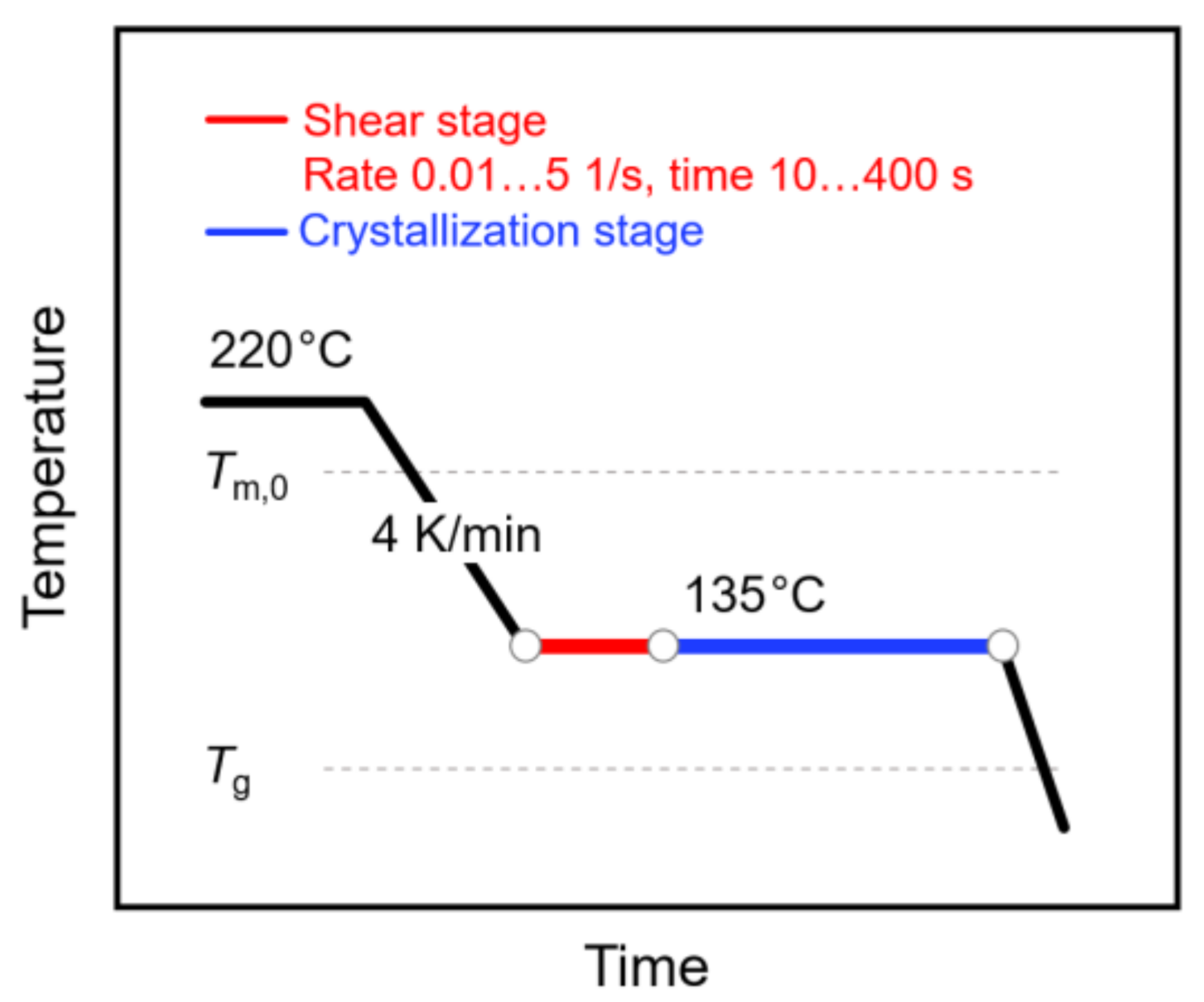

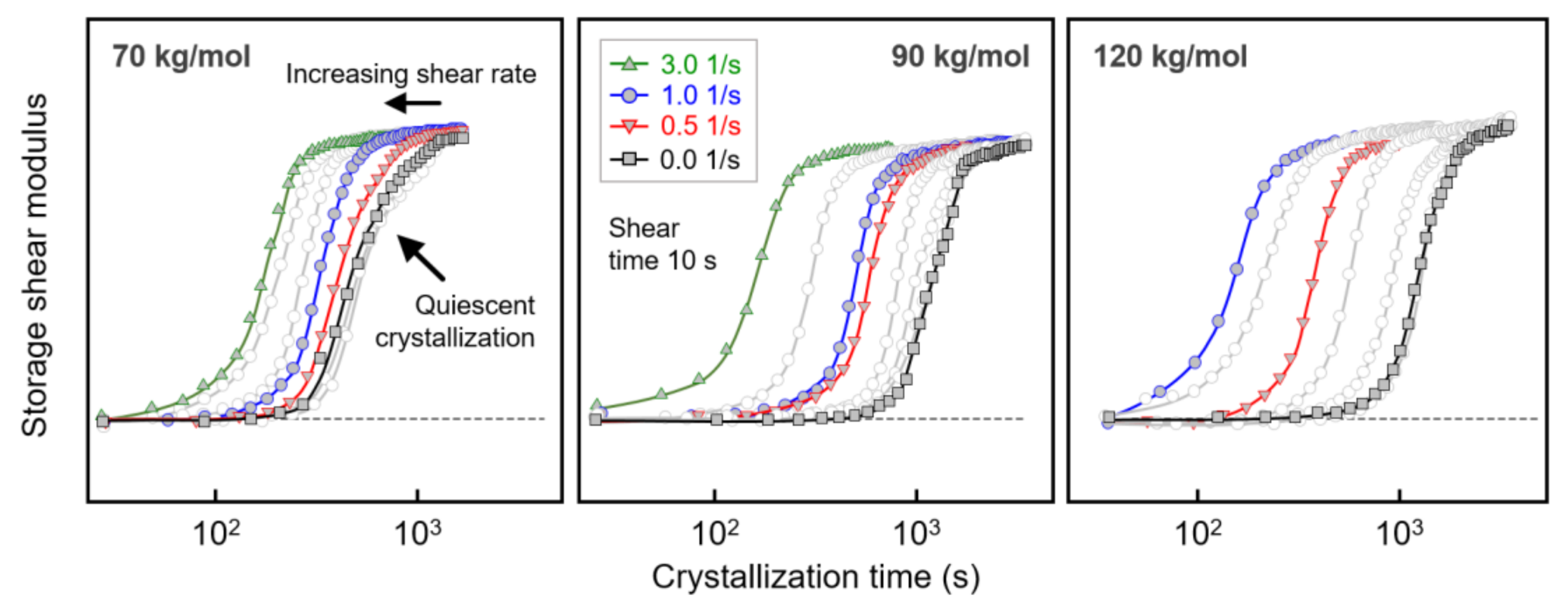
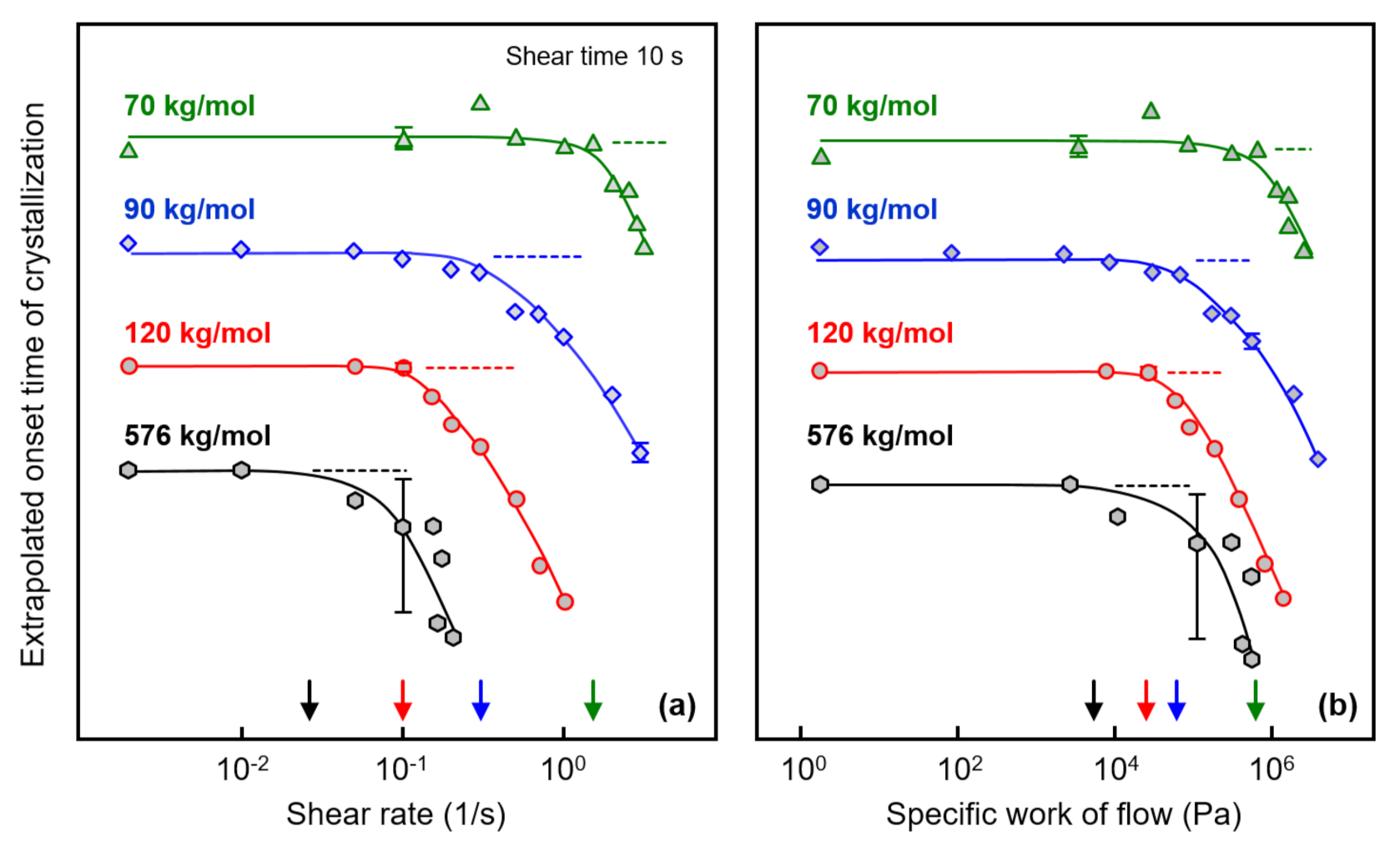
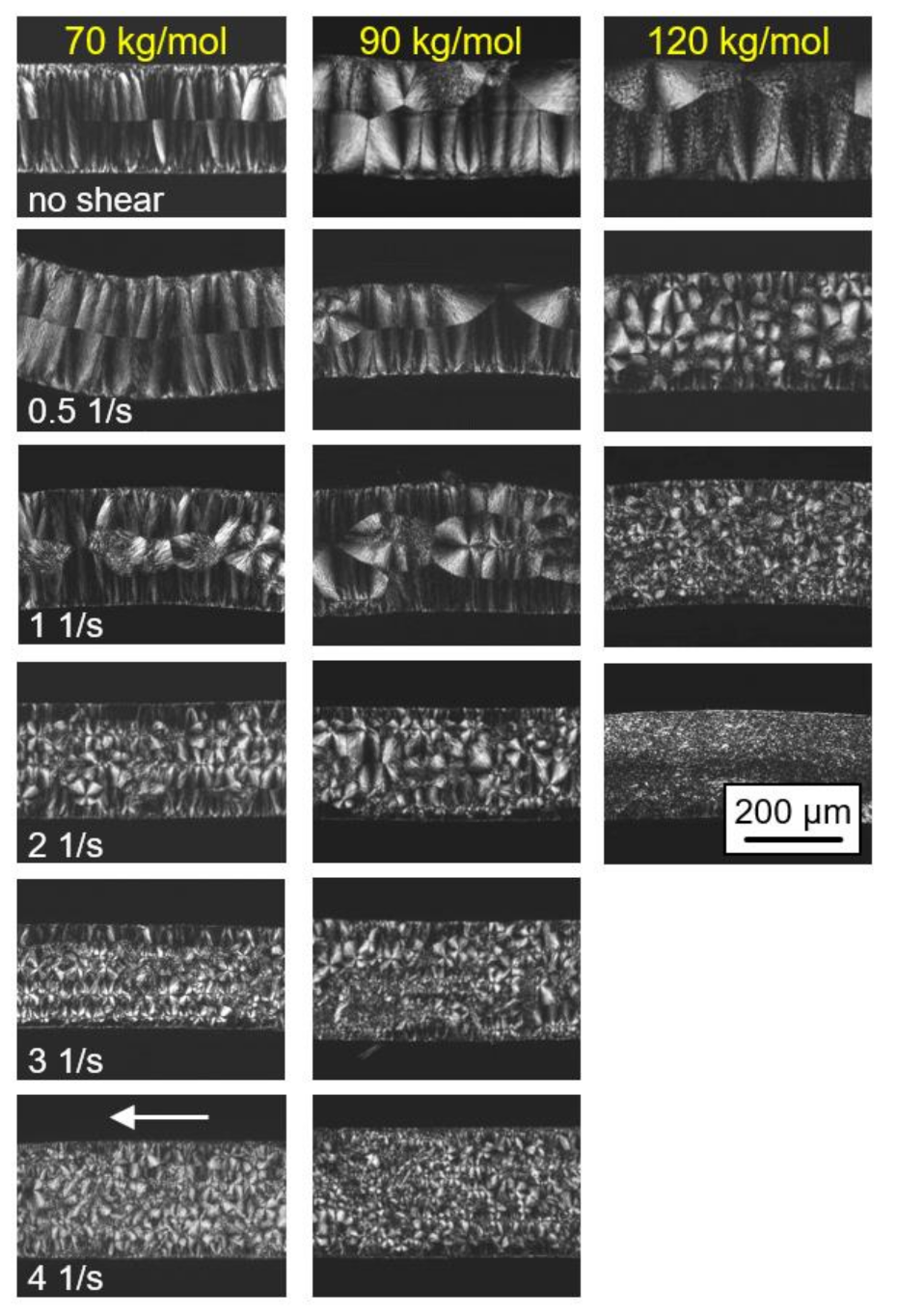
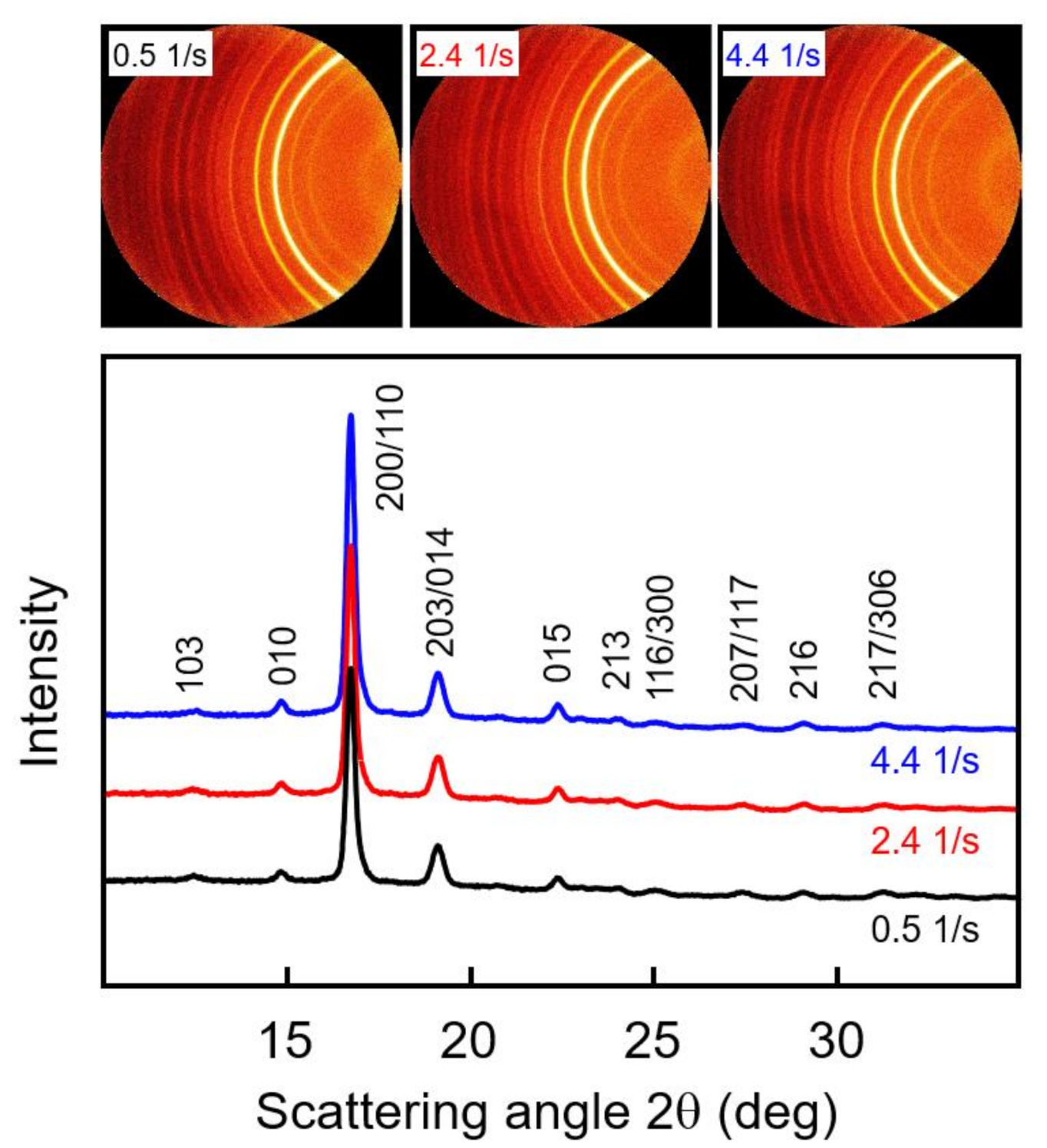

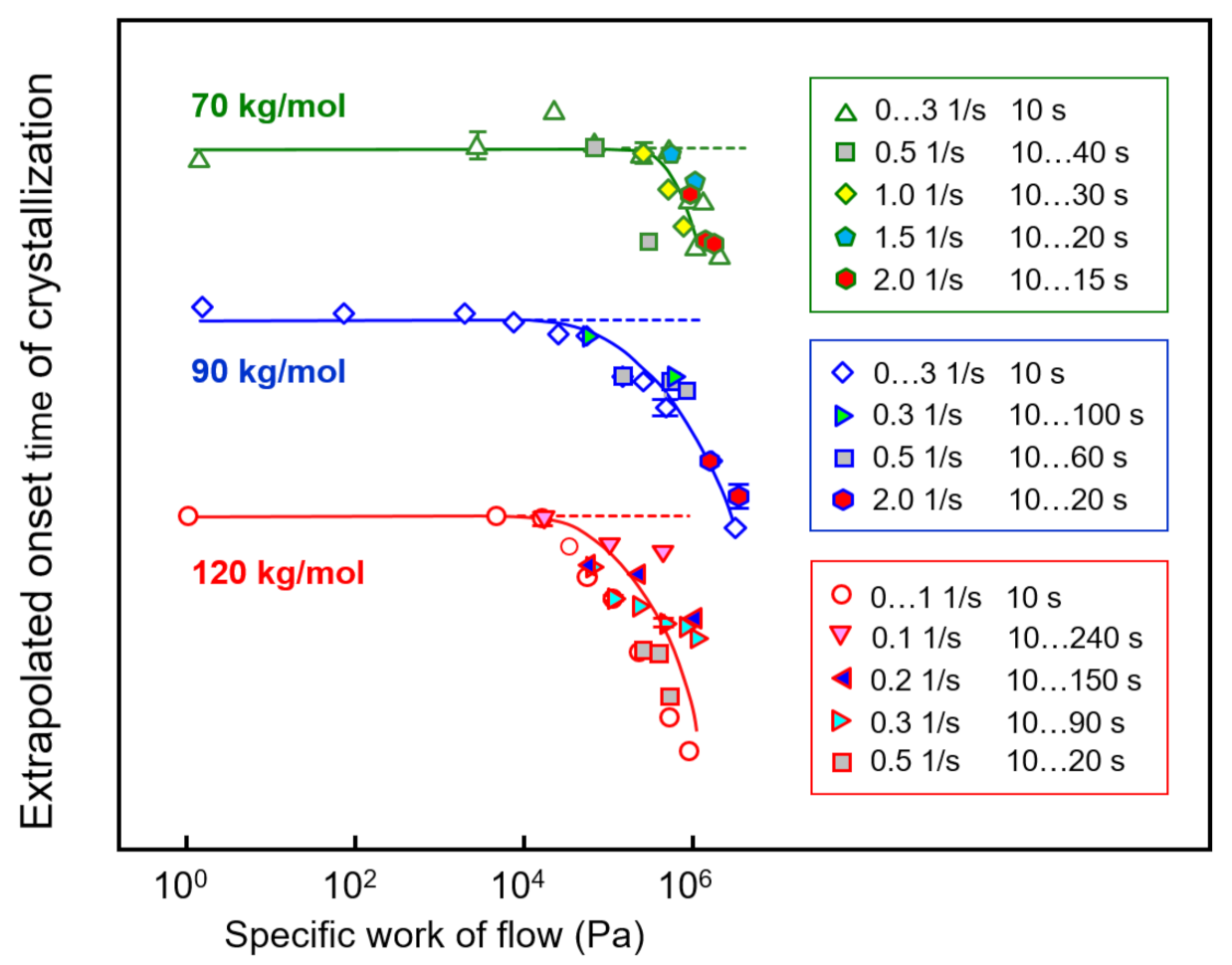
Publisher’s Note: MDPI stays neutral with regard to jurisdictional claims in published maps and institutional affiliations. |
© 2021 by the authors. Licensee MDPI, Basel, Switzerland. This article is an open access article distributed under the terms and conditions of the Creative Commons Attribution (CC BY) license (https://creativecommons.org/licenses/by/4.0/).
Share and Cite
Du, M.; Jariyavidyanont, K.; Kühnert, I.; Boldt, R.; Androsch, R. Effect of Molar Mass on Critical Specific Work of Flow for Shear-Induced Crystal Nucleation in Poly (l-Lactic Acid). Polymers 2021, 13, 1266. https://doi.org/10.3390/polym13081266
Du M, Jariyavidyanont K, Kühnert I, Boldt R, Androsch R. Effect of Molar Mass on Critical Specific Work of Flow for Shear-Induced Crystal Nucleation in Poly (l-Lactic Acid). Polymers. 2021; 13(8):1266. https://doi.org/10.3390/polym13081266
Chicago/Turabian StyleDu, Mengxue, Katalee Jariyavidyanont, Ines Kühnert, Regine Boldt, and René Androsch. 2021. "Effect of Molar Mass on Critical Specific Work of Flow for Shear-Induced Crystal Nucleation in Poly (l-Lactic Acid)" Polymers 13, no. 8: 1266. https://doi.org/10.3390/polym13081266
APA StyleDu, M., Jariyavidyanont, K., Kühnert, I., Boldt, R., & Androsch, R. (2021). Effect of Molar Mass on Critical Specific Work of Flow for Shear-Induced Crystal Nucleation in Poly (l-Lactic Acid). Polymers, 13(8), 1266. https://doi.org/10.3390/polym13081266






